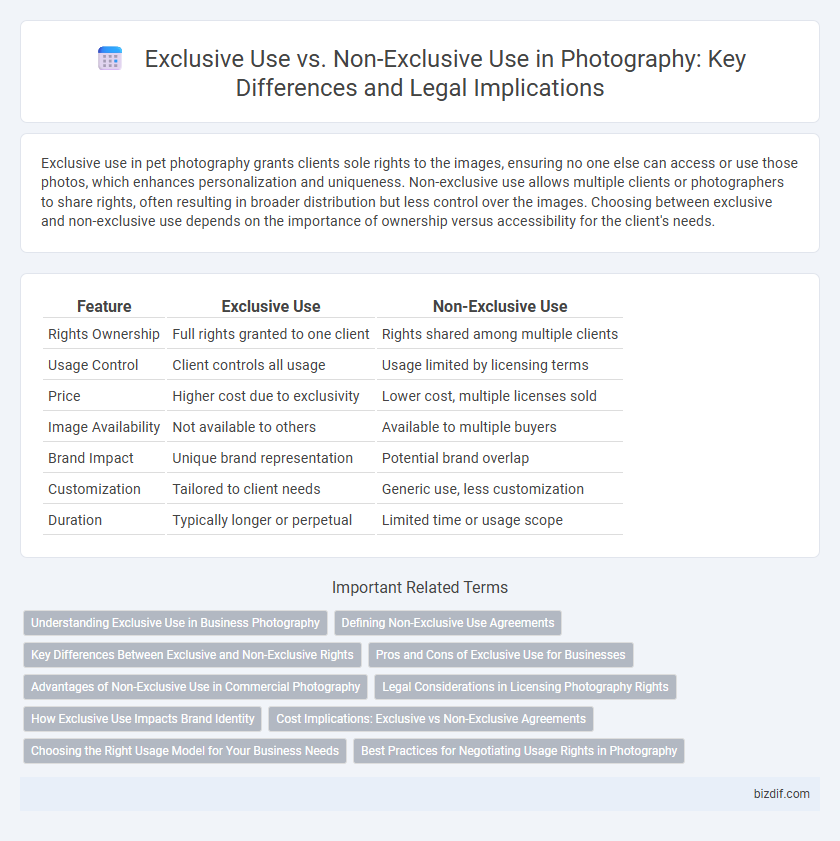Exclusive use in pet photography grants clients sole rights to the images, ensuring no one else can access or use those photos, which enhances personalization and uniqueness. Non-exclusive use allows multiple clients or photographers to share rights, often resulting in broader distribution but less control over the images. Choosing between exclusive and non-exclusive use depends on the importance of ownership versus accessibility for the client's needs.
Table of Comparison
| Feature | Exclusive Use | Non-Exclusive Use |
|---|---|---|
| Rights Ownership | Full rights granted to one client | Rights shared among multiple clients |
| Usage Control | Client controls all usage | Usage limited by licensing terms |
| Price | Higher cost due to exclusivity | Lower cost, multiple licenses sold |
| Image Availability | Not available to others | Available to multiple buyers |
| Brand Impact | Unique brand representation | Potential brand overlap |
| Customization | Tailored to client needs | Generic use, less customization |
| Duration | Typically longer or perpetual | Limited time or usage scope |
Understanding Exclusive Use in Business Photography
Exclusive use in business photography grants a single client full rights to the images, preventing the photographer from licensing or selling the same photos to others. This exclusivity enhances brand uniqueness and protects against image dilution in competitive markets. Securing exclusive rights often involves higher fees but ensures complete control over the visual content's usage and distribution.
Defining Non-Exclusive Use Agreements
Non-exclusive use agreements allow photographers to license their work to multiple clients simultaneously, maximizing exposure and revenue streams without granting exclusive rights. These agreements typically specify the scope, duration, and purpose of use while retaining the photographer's ownership and ability to reuse or resell the images. Clear terms in non-exclusive licenses protect both parties by defining usage limits and preventing unauthorized exploitation of the photographic content.
Key Differences Between Exclusive and Non-Exclusive Rights
Exclusive use in photography grants the buyer sole rights to use, reproduce, and distribute the image, preventing the photographer from licensing it to others, while non-exclusive use allows multiple clients to access and utilize the same photograph simultaneously. Exclusive rights often command higher fees due to their restriction on further distribution, whereas non-exclusive licenses offer more affordable access but with shared usage privileges. The key distinction lies in exclusivity control and the scope of usage, impacting pricing, distribution, and commercial exploitation of photographic works.
Pros and Cons of Exclusive Use for Businesses
Exclusive use licensing in photography grants businesses sole rights to an image, ensuring no competitors can use the same visual asset, which enhances brand uniqueness and strengthens market identity. However, this exclusivity often comes at a higher cost and limits the photographer's ability to license the image to other clients, potentially reducing overall market exposure. Businesses benefit from exclusive use through differentiated branding and reduced risk of image dilution but must weigh these advantages against increased expenses and restricted content versatility.
Advantages of Non-Exclusive Use in Commercial Photography
Non-exclusive use rights in commercial photography allow businesses to license images from multiple photographers or sources, increasing creative flexibility and diversity in marketing materials. This type of licensing is generally more affordable and accessible, enabling brands to acquire a wider range of visuals without the high costs associated with exclusive rights. Non-exclusive licenses also facilitate quicker turnaround times for campaigns by avoiding the restrictions and negotiations tied to exclusive agreements.
Legal Considerations in Licensing Photography Rights
Exclusive use licensing grants one client sole rights to a photograph, preventing the photographer from licensing the image to others, which demands clear contractual terms to avoid legal disputes. Non-exclusive use allows the photographer to license the same image to multiple clients simultaneously, requiring detailed specifications on usage scope and duration to protect intellectual property rights. Understanding these distinctions is crucial for ensuring compliance with copyright law and managing risk in photography licensing agreements.
How Exclusive Use Impacts Brand Identity
Exclusive use of photography rights ensures that brand visuals remain unique, strengthening brand identity by preventing competitors from utilizing the same images. This exclusivity fosters a consistent and recognizable aesthetic, enhancing brand loyalty and market differentiation. Non-exclusive rights, in contrast, risk diluting brand image due to potential widespread usage of identical content across multiple platforms.
Cost Implications: Exclusive vs Non-Exclusive Agreements
Exclusive use photography agreements typically command higher fees due to granting sole rights to the client, limiting the photographer's ability to license the same images to others. Non-exclusive agreements offer cost-effective solutions by allowing photographers to license images to multiple clients simultaneously, spreading revenue across various sources. Businesses balancing budget constraints and intended usage should weigh the premium cost of exclusivity against the broader distribution and affordability of non-exclusive licenses.
Choosing the Right Usage Model for Your Business Needs
Selecting the right usage model for your photography business hinges on understanding exclusive use versus non-exclusive use licenses. Exclusive use grants one client sole rights to the images, ensuring no one else can legally use them, which can command higher prices and foster brand uniqueness. Non-exclusive use allows multiple clients to access the same photos, offering affordability and broader market reach while potentially reducing the images' perceived value.
Best Practices for Negotiating Usage Rights in Photography
Photographers should clearly define exclusive use by granting clients sole rights to images, preventing others from using the same photos, which often commands higher fees and limits future licensing opportunities. Non-exclusive use allows photographers to license the same images to multiple clients, increasing revenue potential but reducing exclusivity value. Best practices include outlining precise usage terms, duration, and geographic scope in contracts, ensuring transparency and protecting both parties' interests during negotiations.
Exclusive Use vs Non-Exclusive Use Infographic

 bizdif.com
bizdif.com